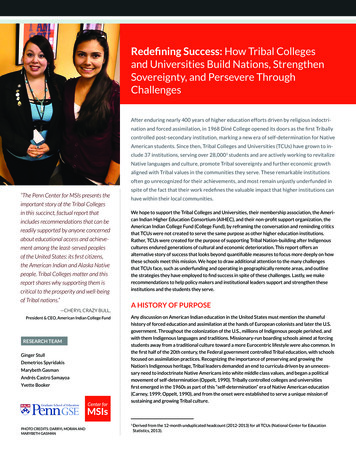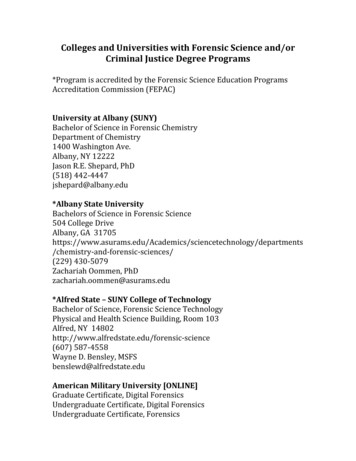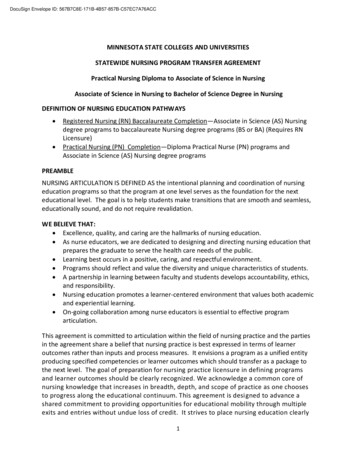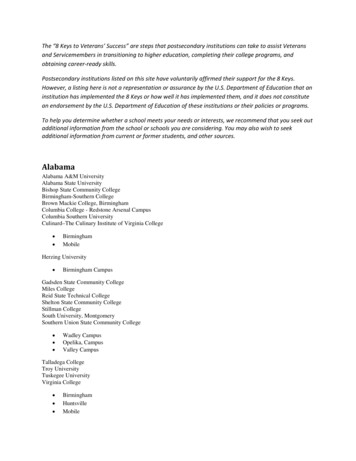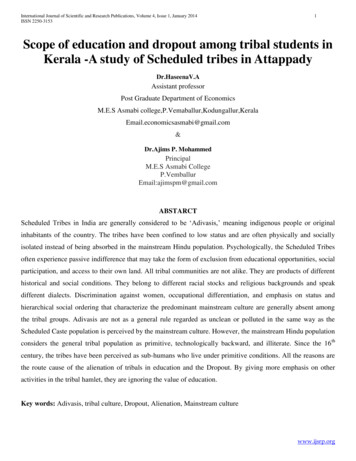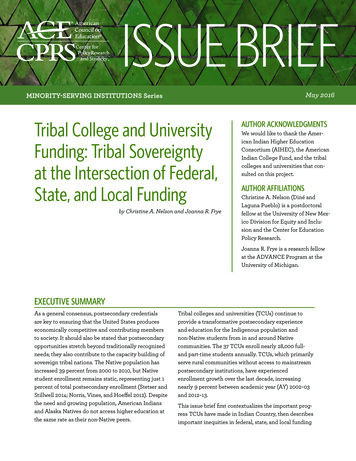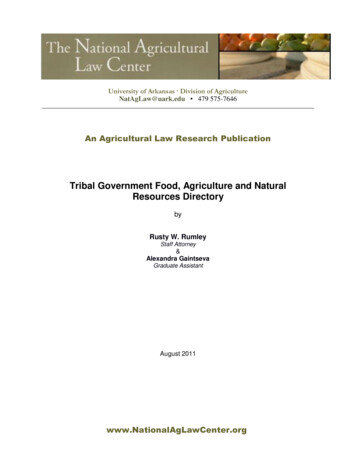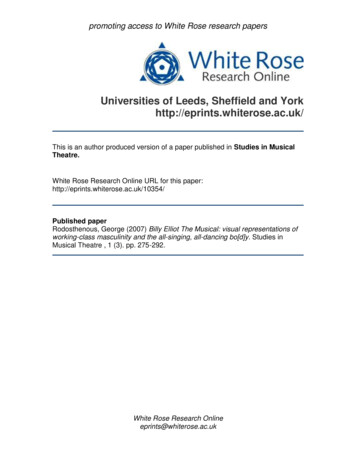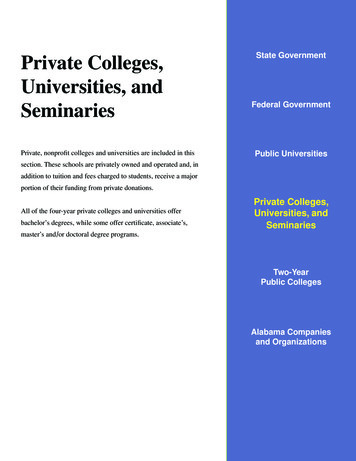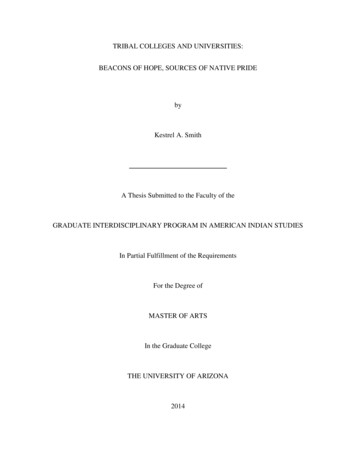
Transcription
TRIBAL COLLEGES AND UNIVERSITIES:BEACONS OF HOPE, SOURCES OF NATIVE PRIDEbyKestrel A. SmithA Thesis Submitted to the Faculty of theGRADUATE INTERDISCIPLINARY PROGRAM IN AMERICAN INDIAN STUDIESIn Partial Fulfillment of the RequirementsFor the Degree ofMASTER OF ARTSIn the Graduate CollegeTHE UNIVERSITY OF ARIZONA2014
STATEMENT BY AUTHORThis thesis has been submitted in partial fulfillment of requirements for an advanceddegree at the University of Arizona and is deposited in the University Library to be madeavailable to borrowers under rules of the Library.Brief quotations from this thesis are allowable without special permission, provided thatan accurate acknowledgement of the source is made. Requests for permission for extendedquotation from or reproduction of this manuscript in whole or in part may be granted by thehead of the major department or the Dean of the Graduate College when in his or her judgmentthe proposed use of the material is in the interests of scholarship. In all other instances,however, permission must be obtained from the author.SIGNED: Kestrel A. SmithAPPROVAL BY THESIS DIRECTORThis thesis has been approved on the date shown below:April 11, 2014Dr. Mary Jo Tippeconnic FoxDateProfessor of American Indian Studies2
ACKNOWLEDGEMENTSThis thesis is truly a culmination of the efforts and support of many wonderful people,many of whom I have been fortunate enough to get to know through this endeavor. First andforemost, I would like to thank my committee chair, Dr. Mary Jo Tippeconnic Fox, and mycommittee members, Dr. Manley Begay Jr. and Dr. Stacey Oberly, for all the knowledge,support, and time that they dedicated to the completion of my research and writing.Also essential to the completion of this study were the efforts provided by the participantswho agreed to complete surveys for my research. While their identities must remain anonymous,I am forever grateful for the time and energy they gave to the completion of the surveys.Furthermore, I would like to thank the Native Nations and the Tribal College communities ofDiné College and Comanche Nation College who provided me with the continued approval andsupport for my research so that I could include them in this study.Additionally, I could not have made it through the Master’s degree program without thesupport of the entire University of Arizona American Indian Studies program faculty, staff, andstudents as a whole, who welcomed me into their academic community two years ago, and whohave supported me at every turn.And finally, I would like to thank my family and friends whose continued supportprovided me with the strength I needed to successfully complete my Master’s program at theUniversity of Arizona. Their everlasting encouragement provided me with the motivation Ineeded in smooth times and in rough.I thank you all from the bottom of my heart, for playing a vital role in the completion ofmy thesis. I will forever be appreciative and I look forward to reciprocating the support later ondown the road.3
Table of ContentsAbstract . 6Chapter 1: Introduction . 7Chapter 2: Literature Review . 12Chapter 3: Methodology . 22Chapter 4: Institutional Profiles . 35Chapter 5: Survey Findings . 62Chapter 6: Tribal College Journal Findings . 89Chapter 7: Conclusions . 127Appendix: Surveys . 134References . 1364
List of FiguresFigure (1): Diné College Logo . 36Figure (2): Diné College Demographics . 36Figure (3): Diné College Campus Map . 39Figure (4): Comanche Nation College Logo . 49Figure (5): Comanche Nation College Demographics. 49Figure (6): The Comanche 4R’s . 55Figure (7): Total TCJ Articles Reviewed: 2008-2013 . 89Figure (8): Keyword Distribution: 2008-2013 . 90Figure (9): Total Keyword Distribution. 915
ABSTRACTThis study examines whether Tribal Colleges and Universities impact hope and pridewithin their surrounding communities. As part of the investigation, data was gathered throughthe distribution of a ten question survey to three participants at both Diné College and ComancheNation College: the president, a student, and a community member. Further data was collectedthrough testimonials gathered from articles within the Tribal College Journal from the past sixyears (2008-2013). The goal of the study is to broaden the understanding of Tribal College andUniversity impacts within their communities, and to provide valuable information for thecollege-community relationship throughout Indian Country.6
Chapter 1: IntroductionPurpose of StudyAs a result of increased accessibility, programs and funding, TCUs are impacting theircommunities’ opportunities for higher education, and contributing to the rebuilding of theirNative Nations. These impacts include increased education and employment of tribal citizens, arevitalization of culture and tradition within Native Nations, and decreased poverty and crime onreservations (The Path of Many Journeys 2007). While these results are undeniably crucial to theunderstanding of TCU impacts on Native communities, this study focuses on an oftenoverlooked effect of Tribal Colleges and Universities. The focus of this study is to determine theattitudinal impacts TCUs have on their surrounding communities. For the purposes of this study,“surrounding community” is defined as the citizenry of the Native Nation that has chartered thespecific TCU.Previous scholarship has recognized the wide range of economic and social impacts thatTCUs have on their communities, ranging from poverty rates, employment rates, graduationrates, free community services (library, internet, meals, and ceremonies), and overall quality oflife (AIHEC AIMS Fact Book 2009–2010 2012). Yet the impacts TCUs have on attitudes withintheir community pertaining to the TCU have been fundamentally overlooked. Essentially, theonly references to impacts on community attitudes exist as briefly-mentioned assumptions withinthe larger context of overall impacts without further exploration or supporting data (AIHECAIMS Fact Book 2009–2010 2012). Rather than accepting these assumptions as fact, this studyelaborates upon the brief references to attitudinal impacts in an effort to begin filling in the gapsin current literature. Introducing evidence through surveys and Tribal College Journal articles7
analyzed for this study helps to develop solid reasoning and further illustrate the impacts TCUsare having on community attitudes.This study concentrates on whether or not TCUs cultivate a sense of hope and pridewithin citizens of its respective Nation, and if so, how these feelings relate to social cohesion andmotivational mindsets within Native communities. “Social cohesion” is defined here as thefeelings of togetherness and unity within the community, as well as the coming together of thecommunity in acknowledgment of a shared devotion to, and bond resulting from, maintainingtheir culture and identity. “Motivational mindsets” is defined here as the enthusiasm andinspiration within the community not only that their Nation is bettering the lives of their peoplethrough offerings at a TCU, but also the encouragement citizens of the Nation feel to achievehigher education. The terms “hope” and “pride” were intentionally left undefined in the initialframework of this study so as to keep them free of the imposition of preconceived definitionsprior to the collection of data. Taking this precaution allowed individual definitions to comeabout naturally through survey and article narratives, and produced a variety of definitionsobservable through the numerous categories that emerged from each term described in laterchapters.Three main research questions guide this study:1) Do Tribal Colleges and Universities impact feelings of hope and pride in citizens ofthe surrounding community?2) If so, how do these impacts relate to social cohesion and motivational mindsets withinthe community?3) What are the similarities and differences in opinions of these impacts betweenadministrators and community members?8
Methods and MethodologyPerspectives of those influenced by TCUs were collected through the use of surveysdistributed to three participants at both Diné College and Comanche Nation College.Specifically, the president, a representative student, and a community member from each of thetwo TCU communities were surveyed. Additional perspectives were gathered through the reviewand collection of narratives from Tribal College Journal (TCJ) articles from the years 20082013. Following the completion of data collection, the analysis of material was guided by thecategorizing method described in the Analyzing Qualitative Data article retrieved from TheUniversity of Wisconsin-Extension’s The Learning Store site (Taylor-Powell and Renner 2003).Subsequent results were interpreted using Terry Huffman’s adaptation of TransculturationTheory, as defined in Theoretical Perspectives on American Indian Education: Taking a NewLook at Academic Success and the Achievement Gap (Huffman 2010). While TransculturationTheory was not designed specifically for TCUs, the applicability to this study exists in the ties toNative culture as a source for academic success both within the principles of the theory as wellas within the philosophies of TCUs’ inherent foundations.For this study, every issue of Tribal College Journal from 2008-2013 was examined forevidence of hope, pride, social cohesion, and motivational mindsets within Native communitiesregarding TCUs. The search was conducted using ten keywords in order to locate specificreferences that might offer relevant evidence. Within this six-year timeframe, 749 articles in totalappeared (not including correction notifications), 56 of which contained one or more keywordswithin a relevant context. This means that only 7.47% of the articles within the 2008-2013timeframe included references relevant to this study. Out of these 56, only one specifically9
addressed the topic of this study. The other 55 articles primarily concerned unrelated TCUtopics, such as research projects TCU students are involved in and new degrees and programsTCUs are developing. Within these 55 articles, the keywords existed as brief statements withinthe larger theme of the article. Further, a total of nine additional sources with one or morerelevant keywords were found in readings outside of the current research; they have since beenincorporated into this study as further evidence of TCU impacts on community attitudes.Combined, the few sentences that exist within the larger context can provide the beginningevidence that TCUs are in fact having an impact on the hope and pride in the citizens of theirNation. Overall, however, this lack of balanced representation within literature demonstrates theneed for more research and discussion in the area of attitudinal impacts.Each of the following chapters presents specific information pertaining to this study’sbackground, methods, and findings. Chapter Two explores the scope of topics discussed incurrent literature regarding American Indian higher education and the Tribal College movement.Chapter Three explains the data collection, analysis, and interpretation methods used in thisstudy to determine the results. Chapter Four illustrates the academic environment at both DinéCollege and Comanche Nation College through an in-depth profile of each institution. ChaptersFive and Six present the survey and Tribal College Journal (TCJ) findings, respectively,determined through the utilization of the methods described in Chapter Three. To conclude,Chapter Seven offers a collective review and conclusion based on the findings presented inChapters Five and Six, recommendations for future study, and closing thoughts.While this study sheds light on thoughts and feelings regarding TCUs within theircommunities, it is in no way intended to make any generalizations about the represented NativeNations as a whole. This study includes a limited number of participants, and as such, the results10
are meant to begin to illustrate the impacts TCUs are having on their communities rather thanmake broad generalizations about an entire Nation. This study strengthens the discussionsurrounding attitudinal impacts TCUs have within Native communities, and begins to fill in thegaps in current literature regarding TCUs as a whole.11
Chapter 2: Literature ReviewHistory of Tribal Colleges and UniversitiesThe history of Tribal Colleges and Universities (TCUs) extends back nearly half acentury to the establishment of Navajo Community College (now known as Diné College) in1968 (History 2013). In a time riddled with challenges and changes, caught between the end ofthe United States (U.S.) federal government’s termination efforts and the start of the selfdetermination era, Native Nations asserted their sovereignty and determination to regain controlover their own people’s education through the development of TCUs. The founders of the firstTCUs recognized the failings of centuries of poor attempts by the U.S. government to assimilateAmerican Indians through Western education. Determined to change the perspectives and livesof Native people by means of offering equivalent education within their own culturally-relevantframework, the TCU movement was initiated. Since then, nearly 40 additional TCUs have beenformed, 34 of them fully accredited by the same organizations that accredits mainstreaminstitutions (TCU Timeline 2013).TCUs are tribally chartered, and as such are a distinctive act of inherent sovereignty heldby Native Nations. In addition to a tribal charter, to be considered a TCU the institution mustalso have a majority of American Indians on a politically-independent governing board as well aswithin the student body (TCU Timeline 2013). Due to the limitation by U.S. legislation to onecollege per Native Nation, TCUs combat this restriction through opening branches across theirrespective reservations. This allows TCUs the ability to reach out and address the need ofaccessibility for their citizens across their Nations. Currently, there are over 75 campuses across15 states with an additional one in the Canadian province of Alberta, (Tribal Colleges and12
Universities 2013) collectively providing an education to over 30,000 students (Tribal Colleges2013).Shortly after the opening of Navajo Community College came the first federal legislationspecifically intended to support TCU operation. In order to assist in funding this institution, theU.S. government passed the Navajo Community College Act in 1971. While funding wasinadequate, this legislation was significant for the reason that the Secretary of the Interiordispensed the funds directly to the Navajo government rather than to the Bureau of IndianAffairs (BIA) to manage for the tribe (Stahl 1979). The next year, in 1972, the American IndianHigher Education Consortium (AIHEC) was founded by the first six TCUs in order to serve as acollective and cooperative resource for TCU leaders and their constituents (About AIHEC 2013).The original six institutions were DQ University, Navajo Community College, Oglala SiouxCommunity College, Sinte Gleska College, Standing Rock Community College, and TurtleMountain Community College (Gipp 2009, 8). Through AIHEC, TCUs share knowledge andwork towards their common goals of expanding Native Nation self-determination efforts overtheir own education, increasing accessibility of higher education to Native students, andadvocating for tribal rights.Less than a decade after the Navajo Nation carried out their own self-determinationefforts with the formation of Navajo Community College, the U.S. government passed the 1975Indian Self-determination and Education Assistance Act (PL 93-638). Federal termination policywas reversed and self-determination of Native Nations became the focus and ultimate goal (TheHarvard Project on American Indian Economic Development 2008, 201). Although many NativeNations were ahead of U.S. policy through their actions in opening their own TCUs prior to thepolicy shift, the passage of this legislation was nevertheless valuable recognition of their goals.13
Motivation within Nations to continue reclaiming control over their own education furtherintensified, and the TCU movement continued to grow.Three years later, through AIHEC’s advocacy efforts, the Tribally Controlled CommunityCollege Assistance Act of 1978 became law (Stein 2009, 24). The federal funding receivedthrough this act was, and still is, minimal, resulting in TCUs struggling to fund basic operations.As part of the 1978 Act, Title I “authorized 6000 per American Indian FTE (full-timeequivalent student). Based on the Consumer Price Index over the past several decades, theauthorization should now be 8,450 per FTE to have kept pace with inflation. Either figure isconsiderably higher than the actual amount of 4,447 per FTE appropriated in the 2005 federalbudget for funding Title 1 the Tribal College Act,” (Stein 2009, 25). Put another way, “thecurrent federal funding per Indian student is at about 75 percent of the authorized level of 6,000per Indian student and lags behind the money received by non-Indian community colleges, whichhave much greater access to federal, state, and local dollars” that TCUs don’t receive (TheHarvard Project on American Indian Economic Development 2008, 212). It is important to notethat this legislation does not provide funding for non-Native students. Consequently, TCUs donot receive funding for every student to whom it provides an education.Such inadequate funding continuously hampers TCUs’ abilities to offer financial aid tostudents, often hindering accessibility of higher education to Native students. In order to assist allNative students in their endeavors to attain higher education, whether at a TCU or not, theAmerican Indian College Fund (AICF) was established in 1989 (About Us: History and Mission2013). AICF works in unison with AIHEC to increase opportunities for Native students to attainhigher educations. AICF raises money through both organizational and individual donors toprovide financial aid to Native students and allow more stude
Diné College and Comanche Nation College who provided me with the continued approval and support for my research so that I could include them in this study. Additionally, I could not hav
